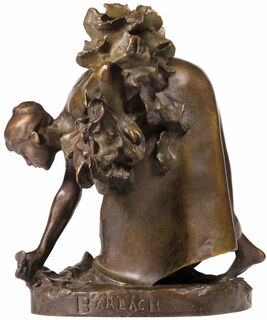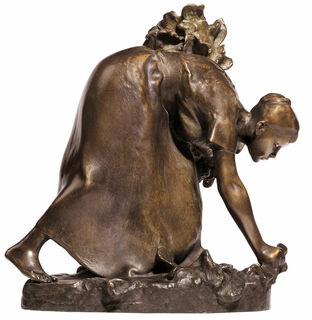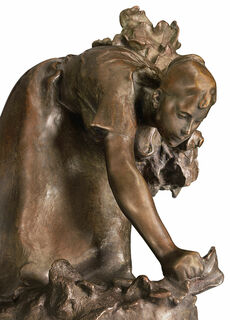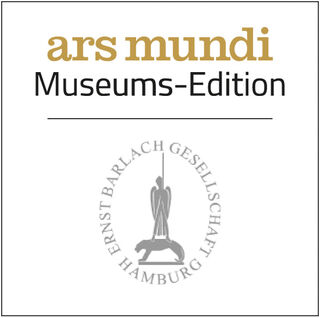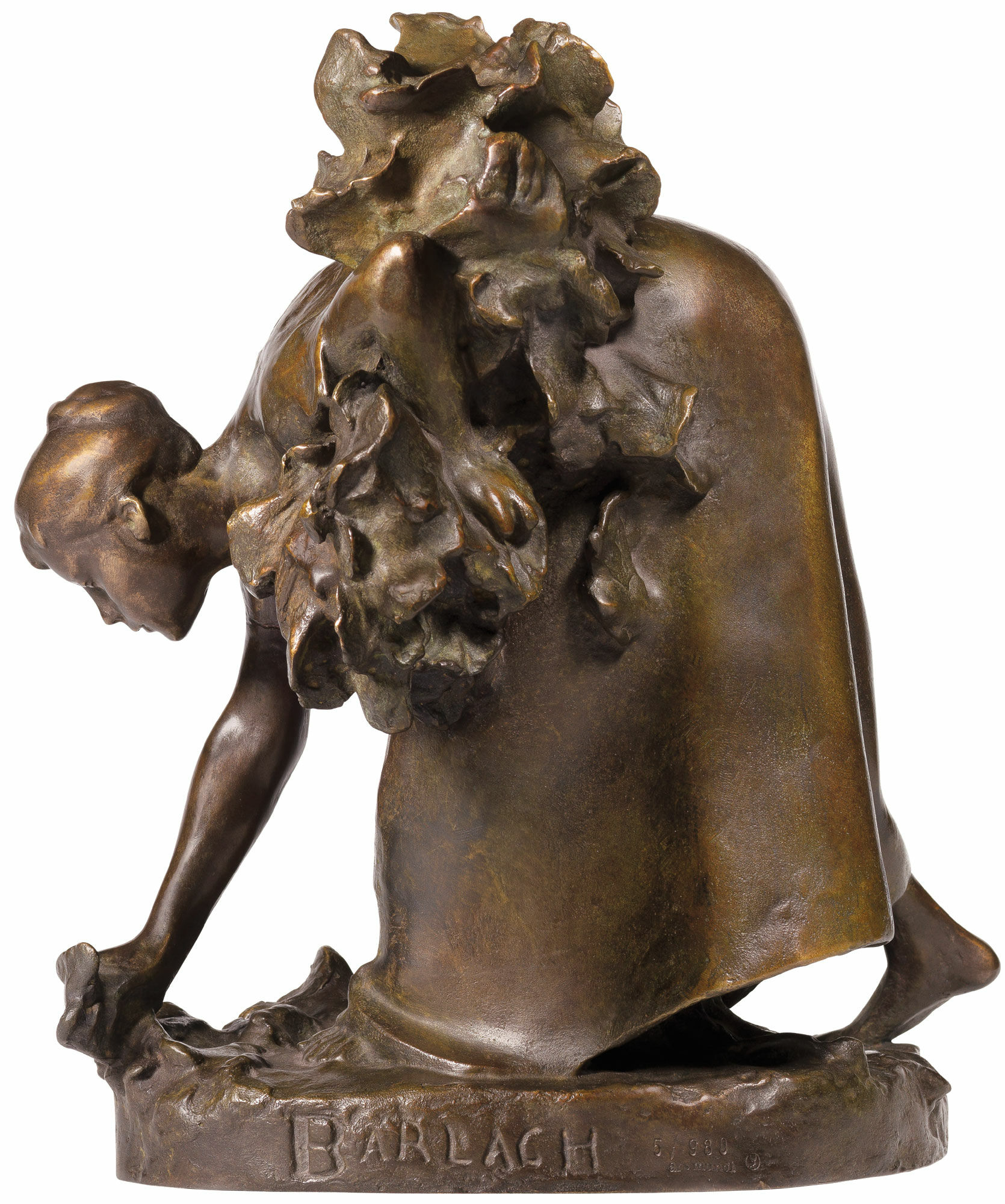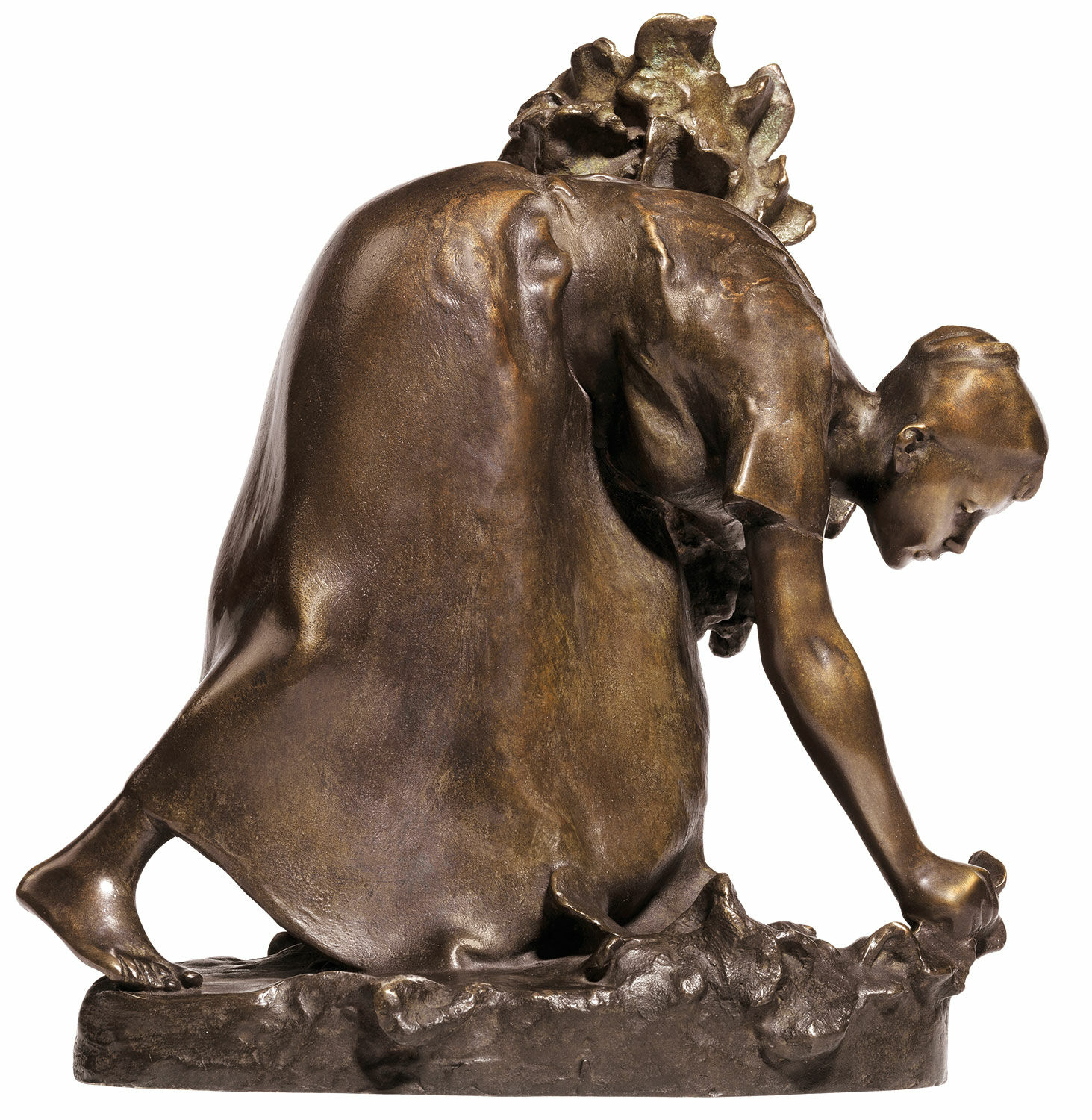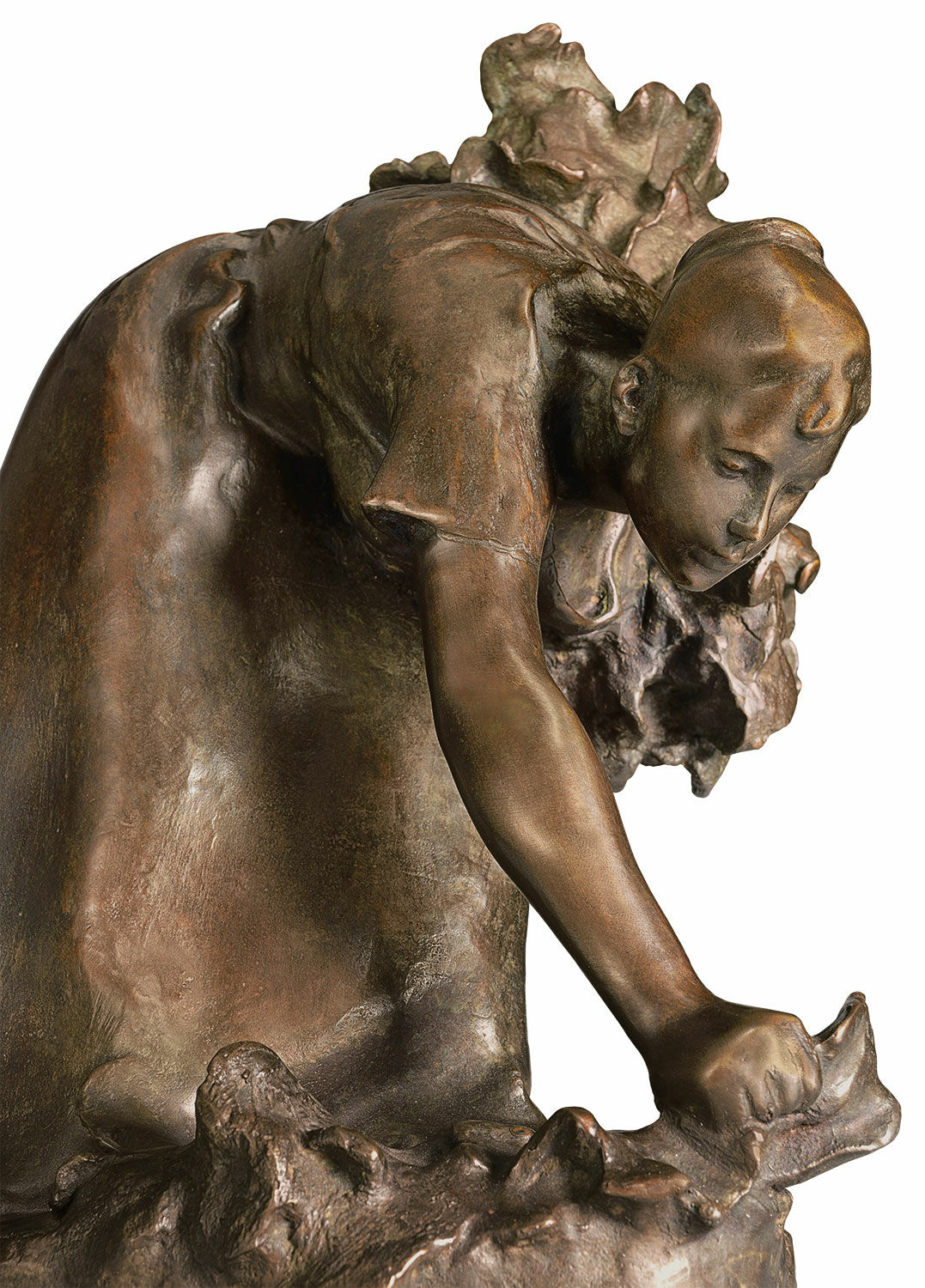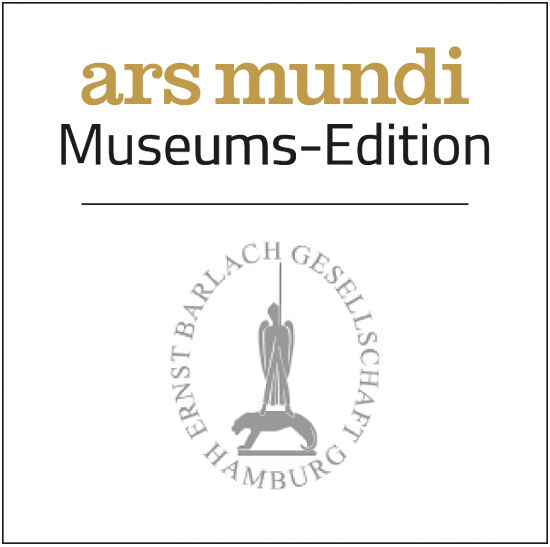Sculpture "The Herb Plucker" (1894), reduction in bronze
Sculpture "The Herb Plucker" (1894), reduction in bronze
Quick info
ars mundi Exclusive Edition | limited, 980 copies | numbered | signature | foundry hallmark | certificate | bronze | patinated | reduction | size 21 x 22.5 x 14 cm (w/h/d) | weight 2.5 kg
Detailed description
Sculpture "The Herb Plucker" (1894), reduction in bronze
Ernst Barlach's masterpiece
Without a doubt, Ernst Barlach was one of the most outstanding personalities of Expressionism and one of the most important artists from Germany. He always placed people at the centre of his artistic work. That is also the case for his "Herb Plucker". It depicts a woman at work in the fields, bending down to pick meadow plants. This sculpture, created in 1894, was Barlach's masterpiece. It was part of his final exams at the Dresden Art Academy in 1895; at the same time, it was his first work to be exhibited at the Great Berlin Art Exhibition in 1898.
Sculpture "The Herb Plucker": Original: tinted plaster.
Fine bronze, cast by hand using the Lost-Wax-Process and patinated. Directly moulded from the original and reduced in size (reduction). Limited edition of 980 copies, individually numbered and with the signature "E. Barlach" taken from the original as well as the foundry hallmark. ars mundi Exclusive Edition, published in cooperation with the Ernst Barlach Society. With numbered certificate of authenticity and limitation. Size 21 x 22,5 x 14 cm (h/w/d), weight 2,5 kg.
"I am constantly fascinated by Ernst Barlach's Herb Plucker'. With this work, the sculptor took a new look at people's everyday lives and, thus, gave sculpture in Germany not only a new impetus but also a new meaning. With this work, he began to bring the common people, the so-called people of the street, back into the real optical field of vision of art." (Dr Jürgen Doppelstein, Chairman of the Ernst Barlach Society)
Customer reviews
Sehr schön
... endlich gibt es auch 'Die Krautpflückerin' als Reduktion in Bronze und gewohnt hoher Qualität… nun kann ich mich täglich daran erfreuen!
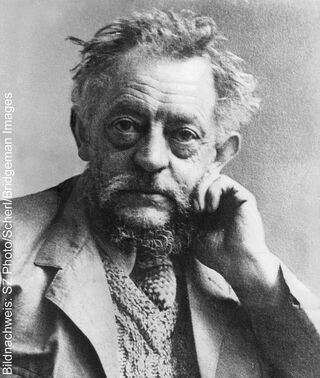
About Ernst Barlach
1870-1938, sculptor, writer and draughtsman
Ernst Barlach was born on January 2, 1870, in Wedel, Germany, and died on October 24, 1938, in Rostock, Germany. He holds an outstandingly special position within German Expressionism. As a graphic artist, draughtsman, writer and, in particular, a sculptor, Barlach created milestones in art history. Barlach's sculptural works of art have a special effect because they seek extreme experience of limits and their representation. They are works of multi-layered meaning with which he foregrounded the essence of the human being and that what stands above the self and the world.
Barlach's intention is rooted in the depths, the inner self. Shaped by war and challenging living conditions, he experiences both suffering and happiness. The human being is always the focus of his work: Ecce homo.
"I desire nothing more than to be a good and true artist as best I can. I believe that what cannot be expressed through the work can pass into the possession of another through forms. My pleasure and creative impulse continually revolve around the problems of the meaning of life and the other great mountains in the spiritual realm." (Ernst Barlach)
Ernst Barlach became an honorary member of the Academy of Fine Arts, Munich, in 1925. In 1933, he was appointed Knight of the Peace Class of the Order "Pour le mérite". In 1937, the National Socialists removed his works from public collections and spaces for being "degenerate art". Ernst Barlach died in Rostock on October 24, 1938.
Today, Ernst Barlach's works are an integral part of leading museums and collections and - if available - fetch record amounts at auction.
"The Singing Man" became Ernst Barlach's best-known sculpture, an icon of Modernism. It adorns illustrated books and posters worldwide, and the original edition is a permanent part of the collections of the world's major museums, including the Museum of Modern Art (MoMA) in New York.
An alloy of copper with other metals (especially with tin) used since ancient times.
When casting bronze, the artist usually applies the lost-wax technique which is dating back more than 5000 years. It's the best, but also the most complex method of producing sculptures.
First, the artist forms a model of his sculpture. It is embedded in a liquid silicone rubber mass. Once the material has solidified, the model is cut out. The liquid wax is poured into the negative mould. After cooling down, the wax cast is removed from the mould, provided with sprues and dipped into ceramic mass. The ceramic mass is hardened in a kiln, whereby the wax flows out (lost mould).
Now we finally have the negative form, into which the 1400° C hot molten bronze is poured. After the bronze had cooled down, the ceramic shell is broken off and the sculpture is revealed.
Now the sprues are removed, the surfaces are polished, patinated and numbered by the artist himself or, to his specifications, by a specialist. Thus, each casting becomes an original work.
For lower-quality bronze castings, the sand casting method is often used which, however, does not achieve the results of a more complex lost-wax technique in terms of surface characteristics and quality.
Graphic or sculpture edition that was initiated by ars mundi and is available only at ars mundi or at distribution partners licensed by ars mundi.
Artistic movement that replaced Impressionism in the early 20th century.
Expressionism is the German form of the art revolution in painting, graphic art and sculpture, which found its precursor in the works of Paul Cézanne, Vincent van Gogh and Paul Gauguin in the late 19th century. The Expressionists attempted to advance to the primal elements of painting. With vibrant, unbroken colours in large areas and with the emphasis on the line and the resulting targeted suggestive expressiveness, they fought against the artistic taste established by the bourgeoisie.
The most important representatives of Expressionism were the founders of "Die Brücke" (The Bridge): Ernst Ludwig Kirchner, Erich Heckel, Karl Schmidt-Rottluff, Max Pechstein, Otto Mueller and Franz Marc, August Macke and others.
Masters of Viennese Expressionism are Egon Schiele and Oskar Kokoschka. Among the sculptors, Ernst Barlach is the most famous.
Fauvism is the French form of Expressionism.
Depiction of typical scenes from daily life in painting, whereby a distinction can be made between peasant, bourgeois and courtly genres.
The genre reached its peak and immense popularity in Dutch paintings of the 17th century. In the 18th century, especially in France, the courtly-galant painting became prominent while in Germany the bourgeois character was emphasised.
A plastic work of sculptural art made of wood, stone, ivory, bronze or other metals.
While sculptures from wood, ivory or stone are made directly from the block of material, in bronze casting a working model is prepared at first. Usually, it is made of clay or other easily mouldable materials.
The prime time of sculpture after the Greek and Roman antiquity was the Renaissance. Impressionism gave a new impulse to the sculptural arts. Contemporary artists such as Jorg Immendorf, Andora, and Markus Lupertz also enriched sculptures with outstanding works.

